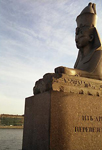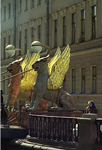One- and two-days tours to St. Petersburg
Moscow
- * Departure to St Petersburg by overnight train
Thursday, May 25
- St. Petersburg
- Arrival in St Petersburg 07:50
- Early breakfast at the local cafe
- City tour including Peter & Paul Fortress, St I
- Hermitage (3 hours)
- Boat trip along the canals
- Dinner at the local restaurant
- Transfer to the railway station to go to Moscow by overnight train
- Or Transfer to the Hotel (4**** stars)
Price : Euro 156/ *215 per person (1 day in St. Petersburg includes all transport and
Ticket supplement: Euro 160 for a return ticket 2nd class, Euro 280 for a return ticket 1st class
Optional: you can stay another day in St Petersburg:
Friday, May 26
St Petersburg - Breakfast in the Hotel (4**** stars)
- Trip to Petergoff + excursion (5 hours)
- Lunch at the local restaurant
- Transfer to the railway station to go to Moscow by overnight train
Price: Euro 312/*375 per person (2 days in St. Petersburg includes all transport and transfers, English speaking guide and entrance tickets, Lunch and Dinner, Hotel (4**** stars)in double room)
Ticket supplement: Euro 160 for a return ticket 2nd class, Euro 280 for a return ticket 1st class
The specified prices operate for group from 35/*15 person
You can contact directly "IntelService Center" - the official travel agent of Cold Climate HVAC conference abok@intelservice.ru
St.Petersburg
|
|
The History of St. Petersburg
The city of St. Petersburg is relatively young according to European and Russian standards. Founded in 1703 it will celebrate only 300th anniversary in year 2003. Though the city is rather young it has rich and fascinating history. Since the days of Peter I's "Paradise" and "North Venice" till nowadays St. Petersburg has been living an interesting life.
Since its birth Petersburg was the city of myths and mystery. You can hardly find such a young city wrapped in exciting stories, astonishing myths and mysterious legends. The unique history of the city is not only reflected in numerous rumors and still alive in destiny of people gazing through time from old portraits. The whole sophisticated development of St. Petersburg is materialized in its palaces and temples, park ensembles, street labyrinths and multistoried houses.
Like any other large city St. Petersburg will tell his stories to every attentive and interested observer. Outstanding personalities of culture and history - military leaders, courtiers, tsars and princes, artists and poets, writers and travelers lived and walked here. Come here to adore this "North Venice" of Peter the Great and his magnificent daughter Elizabeth; the city made the Russian Empire great power; where Lomonosov, Derzhavin, Pushkin, Gogol and Dostoevsky wrote their masterpieces. Come to get to know the history of St. Petersburg, White Nights of mysterious North Palmira and to see the spires of the Admiralty and Peter and Paul Fortress.
THE CITY OF ST. PETERSBURG TODAY
|
|
|
|
POPULATION
According to the latest census, taken in 2000, 4,695,000 people currently live in St. Petersburg.
CLIMATE
The St. Petersburg climate is influenced by the huge expanses of the Atlantic Ocean and its immediate proximity to the Gulf of Finland; water also accounts for 10% of the city's area - a great number of rivers, lakes and marshes. The region varies from a marine to a continental climate, mild and humid, with a significant amount of cloudy weather, frequent mists and substantial rainfall. In summer the city enjoys periods of hot, dry weather when the temperature can reach 35 degrees C. The average temperature in winter is - 7.8 degrees C.
AGE
St. Petersburg will shortly be celebrating its 300th anniversary. Peter I founded a new Russian fortress on little Hare Island in the Neva delta in 1703 and called it Sankt-Piterburgh. Work on the fortifications started in 1704; Peter and the city's first governor, Alexander Menshikov, decided to make St. Petersburg the new capital of Russia, which would not suffer in comparison with any other European capital in its splendour and importance. The general design for the city was drawn up by the architects Trezzini, Korobov and Yeropkin. They laid the basis for the planning of the new city with a trident of main avenues fanning out from the Admiralty.
TERRITORY
The city has an area of 606 sq. km., but if you include the immediate suburbs on the lowlands along the Neva and the Gulf of Finland, it is 1439 sq. km. The city measures 44 km from north to south and 25 km from east to west. St. Petersburg developed according to a strict, well thought-out plan, which had been finalised by 1712. The wide Neva and all the numerous other rivers and canals were incorporated into the city's design and created its scale. 1865 saw the division of the city into 12 administrative sections. It is now divided into 20 administrative districts.
THE CENTRE
The historic centre of the city is Palace Square, which incorporates the Winter Palace, the General Staff Headquarters and Ministries Buildings. The Winter Palace used to be the Imperial residence. Several rooms in the palace were used to house unique works of art, and these rooms came to be known as the Hermitage. Later more buildings were constructed for the growing collections - the Small Hermitage, the Great Hermitage, the Hermitage Theatre and the New Hermitage. All these buildings now make up the State Hermitage - an enormous museum of art, history and culture. The collection includes paintings by Rubens, Rembrandt, Leonardo da Vinci, Titian and many other artists, as well as historical and cultural objects from many countries.
THE VENICE OF THE NORTH
St. Petersburg is built on 42 islands at the Neva delta where the river flows into the Gulf of Finland. It is one of the world's leading cities in terms of its number of rivers, islands and bridges. St. Petersburg is sometimes called a museum of bridges - it has over 300 of them. 69 rivers and other waterways flow through the city and its immediate environs; within the city limits there are 40 rivers, tributaries, canals and other waterways with a total length of 217.5 km. The principal ones are the Great and Lesser Neva, the Great, Medium and Lesser Nevka, the Fontanka, the Karpovka, the Okhta, the Zhdanovka, the Moika, Chernaya Rechka and the Obvodnyy Canal.
THE MAIN STREET
Nevsky Prospekt is St. Petersburg's main street. It began with the clearing of a straight cut through the forest and the building of a road on it. The straight, wide thoroughfare starts from the Admiralty, passes through Ploshchad Vosstaniya and ends at the Alexander Nevsky Monastery. It was named after Alexander Nevsky (or possibly after the monastery, which was also called Nevsky). The city's main highway contains St. Petersburg's major shops, theatres and museums.
ISLANDS
In the early 20th century there were more than 100 islands in the city, but as a result of engineering work to develop the marine facade their number was reduced to 42. There are over 580 bridges, including 20 that can be raised (7 of these cross the Neva); the total area occupied by the river within the city's boundaries is 32 km (its total length from Lake Ladoga to the Gulf of Finland is 74 km). The length of the marine embankment within the limits of the modern city is about 35 km.
ST. PETERSBURG - A NAVAL CITY
A great deal in St. Petersburg's artistic decoration is reminiscent of the city's naval glory, which is inextricably linked with the expanses of the Baltic Sea. Peter I did all he could to ensure that the sails of Russian ships were seen along the Baltic coast. Russia became a formidable naval power, confirming its superiority with glorious victories and round-the-world voyages. THEATRES St. Petersburg's first theatre was opened by Peter I's sister Natalya in 1709. The city is famous for its theatres - not only for the companies, but for the beauty of the theatres themselves. From the earliest years of St. Petersburg theatres were built into the Imperial palaces, while the imposing, monumental buildings of the public theatres were erected on the city's squares. St. Petersburg is rightly known as the cultural capital. The city boasts one of the oldest circuses in the country, opened in 1877. A great contribution to the musical heritage of the city and the country is made by the Shostakovich Philharmonia and the Glinka State Academic Capella.
ARCHITECTURAL MONUMENTS
Among St. Petersburg's unique attractions are its numerous palaces, constructed in the 18th and 19th centuries, when the city was the capital of the Russian state; they formed the ceremonial face of the city. Several of the palaces and other buildings are outstanding examples of world architecture. They include the vast Winter Palace, the principal feature of Palace Embankment and Palace Square. Also worthy of attention are the Mikhailovsky Palace, the architecture along Nevsky Prospekt and the Engineers' Castle, which overlooks the expanse of the Field of Mars.
CATHEDRALS AND CHURCHES
St. Petersburg has 10 cathedrals, 39 Orthodox churches, Lutheran and Roman Catholic churches, an Armenian-Gregorian church, a Buddhist temple, a Muslim mosque and two synagogues. The world-famous cathedrals are: the Alexander Nevsky Cathedral of the Holy Trinity - one of the leading examples of 18th century Russian ecclesiastical architecture; the Cathedral of Our Lady of Kazan - a monument of Russian military glory, featuring trophies from the Patriotic War of 1812; and an example of classicist architecture - the Cathedral of the Resurrection of Christ ("The Saviour on the Blood").
MEMORIALS OF MILITARY GLORY
Patriotism, heroism, self-sacrifice and valour arouse particular respect. It is not surprising that the people's feats of arms are reflected in the splendid architecture, the numerous monuments and the names of streets and squares in St. Petersburg. THE SUMMER GARDEN The Summer Garden is one of the favourite spots in our city for locals and visitors alike. It is situated in one of the outstanding sections of embankment on the left bank of the Neva and occupies nearly 12 hectares. The garden was created in 1704 according to an idea of Peter I; it became his formal residence and the city's greatest adornment.
ARTS' SQUARE
Arts' Square (Ploshchad Iskusstv) comprises the Russian Museum, the Mussorgsky Opera House, the Musical Comedy Theatre, the Great Hall of the Philharmonia and the Ethnographic Museum. From 1819-1825 a palace designed by architect Karl Rossi was built for Tsar Alexander I's brother Mikhail. Today the Mikhailovsky Palace is the home of the Russian Museum, one of the world's great museums containing the largest collection of Russian fine arts: ancient icons, paintings by Kiprensky, Shchedrin, Venetsianov, Bryullov, Kramskoy, Repin, Surikov, Serov and Vrubel, portraits by Nikitin, Rokotov, Argunov, Levitsky and Borovikovsky.
PETER AND PAUL FORTRESS
Peter and Paul Cathedral is the oldest church in St. Petersburg; building started within a month of the city's foundation on 29 June 1703. It was completed on 1 April 1704 and dedicated to the Holy Apostles Peter and Paul. Peter and Paul Fortress is the Imperial burial-vault: it contains the remains of almost all the Russian Emperors and Empresses. Marble sarcophagi are installed over the graves of the Tsars and members of their families.
THE SUBURBS
Over the course of two centuries from St. Petersburg's foundation in 1703, magnificent palace and park complexes were constructed close to the Russian capital: Peterhof (Petrodvorets), Strelna, Oranienbaum (Lomonosov), Tsarskoye Selo (Pushkin), Pavlovsk, Gatchina and a number of other country residences for Emperors, Grand Princes and grandees. They reflect all stages in the development of Russian architecture and landscaping from the 18th to 20th centuries.
www.petersburg-russia.com
www.hermitagemuseum.org
Additional information for tours in Russia travel.in-russia.com




